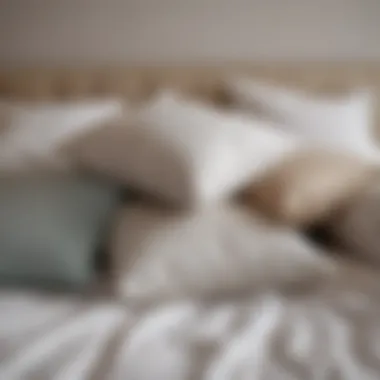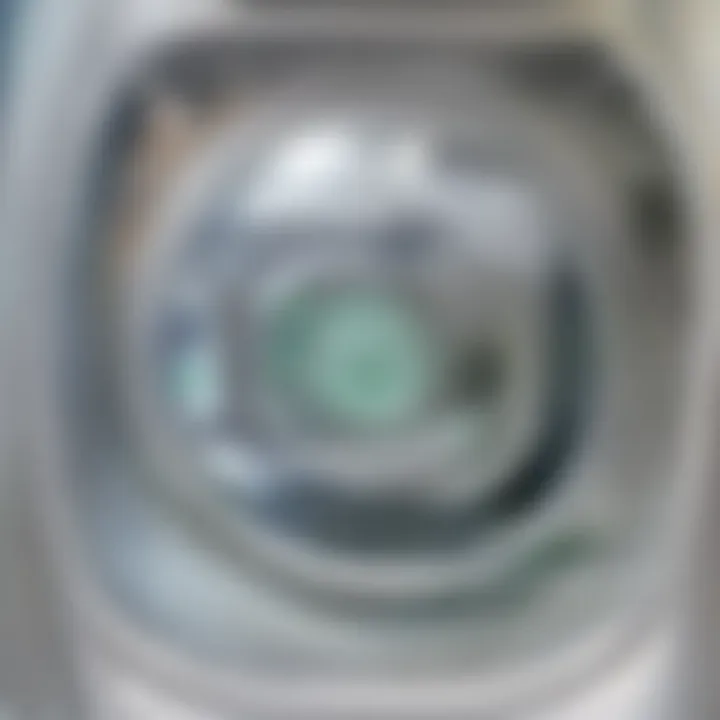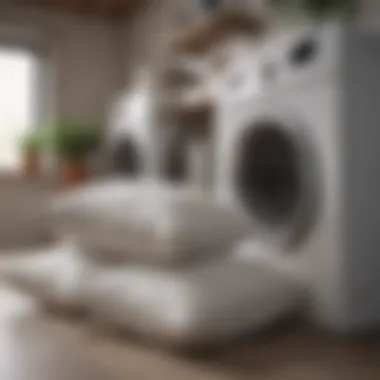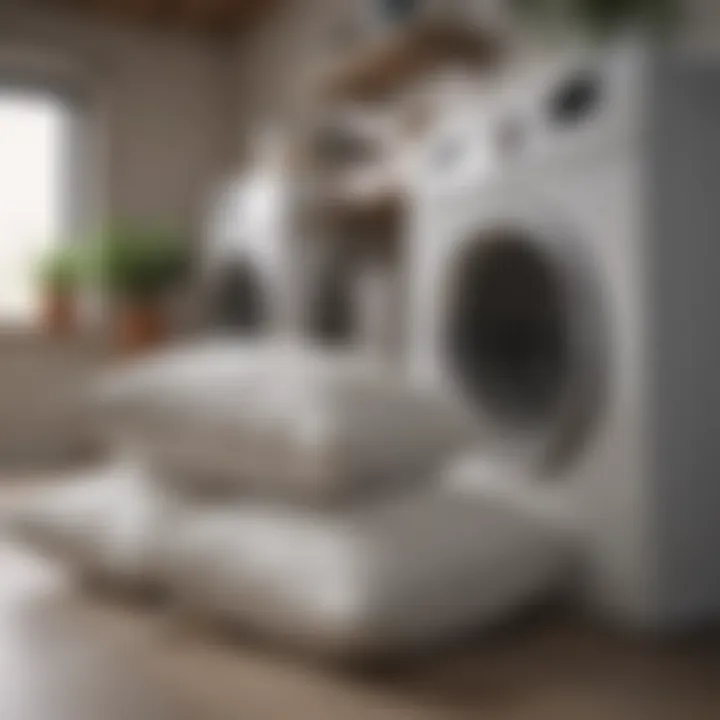The Ultimate Guide to Washing Pillows Effectively


Intro
Washing pillows is a task often overlooked in the realm of home hygiene. Many individuals do not realize the importance of maintaining clean pillows for better sleep quality and overall health. This guide aims to furnish you with methods and knowledge necessary for washing various types of pillows and ensuring their longevity. By exploring washing techniques, appropriate cleaning products, and drying methods, you will not only enhance the condition of your pillows but also improve the hygiene of your sleep environment.
In this piece, we will delve into different pillow types, the science behind proper washing methods, and the significance of routine cleaning. Knowing how to care for your pillows can lead to a more pleasant sleeping experience while minimizing allergens and improving your living space.
Types of Pillows
Understanding the different types of pillows available is crucial when embarking on the task of washing them. Each type may require a distinct approach, depending on the filling and fabric. Below are common pillow types:
- Memory Foam: Known for their contoured support, memory foam pillows often cannot be washed in a machine. Spot cleaning is usually the best method.
- Down and Feather: These pillows provide softness and insulation but require specific washing techniques to avoid clumping.
- Synthetic: Hypoallergenic materials are widely used in synthetic pillows. They can usually be machine washed without issue.
- Latex: Similar to memory foam, latex pillows should often be spot cleaned instead of fully immersed in water.
Identifying the type of pillow you have will dictate the cleaning process and help you make informed decisions.
Washing Techniques
Proper washing techniques are vital for preserving the structure and material of pillows. Consider these steps:
- Check Care Labels: Always start by checking any care labels that accompany your pillows. These provide specific recommendations that are best followed.
- Pre-Treat Stains: Use a mild detergent or spot cleaner for any visible stains. Let it sit as per product instructions before washing.
- Machine Wash (For Appropriate Types): If the pillow label allows for machine washing, add one or two pillows to your washing machine along with a gentle detergent. Opt for a gentle cycle with warm water to avoid damage.
- Rinse Thoroughly: This step is vital to remove all detergent residues which might irritate your skin.
- Air Dry or Tumble Dry: For pillows that hold their shape, such as synthetic types, tumble dry on low heat. For others, air drying may be the safest option.
It is important to follow these steps carefully to ensure cleanliness without damaging your pillows.
Importance of Regular Cleaning
Regular cleaning of pillows should not be dismissed. Over time, pillows accumulate dust mites, allergens, and bacteria, which may lead to health issues and poor sleep quality.
Regular washing can reduce allergens and improve your sleep environment, leading to a healthier life.
Moreover, clean pillows can improve aesthetic appeal in your bedroom. They contribute positively to the overall feel of your living space.
Prelude to Pillow Hygiene
Pillow hygiene is a critical aspect of maintaining a clean and healthy living environment. Pillows are not just support for your head while sleeping; they also accumulate various contaminants over time. Understanding how to properly clean and maintain them enhances not only the longevity of the pillows but also promotes better health and overall well-being.
Significance of Regular Pillow Cleaning
Regularly cleaning pillows is essential for several reasons. Firstly, it prevents the buildup of allergens such as dust mites, mold, and mildew, which can provoke respiratory issues and allergies in sensitive individuals. Secondly, clean pillows contribute to having better sleep quality. A fresh pillow enhances comfort, reduces irritants, and helps create a more restful sleep environment. Overall, the practice of cleaning pillows can lead to improved health outcomes and a more pleasant sleeping experience.
It is often overlooked that pillows should be washed at least every six months. Neglecting this can lead to an increased risk of skin infections due to bacteria thriving in dirty environments. In addition, greasy hair and skin products can transfer onto pillows, rendering them unsanitary after prolonged use. The effort invested in maintaining pillow hygiene is minimal compared to the benefits gained, both for health and comfort.
Common Pillow Contaminants
Pillows can harbor a variety of contaminants that are often invisible to the naked eye. Some of the most common include:
- Dust Mites: Microscopic creatures that thrive in warm environments. They feed on dead skin cells shed by humans.
- Mold and Mildew: These can develop in pillows containing natural materials, especially if they become damp.
- Bacteria: Human saliva, sweat, and oils can accumulate, providing a breeding ground for bacteria.
- Skin Flakes and Hair: Regular shedding occurs, resulting in a gradual buildup within the pillow fabric.
- Pet Dander: For those living with pets, dander can become trapped in pillows, contributing further to allergens.
Understanding these common contaminants underscores the necessity for regular pillow cleaning. Eliminating them contributes to overall bedding hygiene and improved sleep quality.
Types of Pillows and Their Unique Care


Understanding the various types of pillows and their unique care is essential for maintaining hygiene and longevity. Each pillow type has specific characteristics and materials that influence how they should be cleaned. By applying the right techniques, you can preserve the integrity of the pillow while enhancing your sleep environment. This section focuses on four types of pillows: Memory Foam, Down and Feather, Synthetic Fill, and Latex, each requiring different care methods to ensure they remain fresh and supportive.
Memory Foam Pillows
Memory foam pillows are known for their ability to conform to the shape of the head and neck. This quality offers excellent support but requires specific cleaning care. Washing these pillows in a machine can lead to damage, as they can lose their shape and firmness. A more suitable method involves spot cleaning with a mild detergent and a damp cloth. If deeper cleaning is necessary, it’s advisable to check for manufacturer guidelines first. When washing, avoid using hot water or harsh chemicals, as these can deteriorate the foam’s quality. Ensuring proper drying is crucial; air drying is best to prevent mold and retain shape.
Down and Feather Pillows
Down and feather pillows offer a luxurious comfort as they are soft and often plush. However, cleaning them can be tricky. These pillows should be washed using a front-loading washing machine, if available, to avoid damaging them. Use a gentle detergent and set the machine to a delicate cycle. Adding dryer balls during drying helps maintain fluffiness. It’s significant to ensure that they are completely dry, as moisture can lead to mildew. For maintenance, regular fluffing and airing out pillows can prevent clumping.
Synthetic Fill Pillows
Synthetic fill pillows are often more durable and easier to care for compared to their natural counterparts. Machine washing these pillows is generally safe. Use warm water and a gentle detergent. It's also advisable to wash two pillows at once to balance the load in the washing machine. After washing, tumble dry on low heat with dryer balls to aid in fluffing. These pillows do not retain odors as easily, but regular washing helps to keep allergens at bay, contributing to cleaner sleep.
Latex Pillows
Latex pillows are known for their resilience and support. Like memory foam pillows, they should not be machine washed. Instead, they can be cleaned using a damp cloth and a mild soap solution. Avoid soaking them in water, as this can compromise their structure. Air drying is recommended to prevent any dampness that could lead to mold growth. It is also helpful to frequently use pillow protectors to shield against spills and stains, ensuring better longevity.
Each type of pillow has its own specific care requirements. Understanding these can significantly extend the life of your pillows while ensuring a clean sleeping environment.
Preparing Pillows for Washing
Pillows play a crucial role in our sleep quality and overall health. Preparing them properly for washing ensures they are cleaned effectively, prolonging their life. Proper preparation can prevent damage during the cleaning process and maintain the pillow’s integrity. Understanding the steps involved in preparing pillows is essential for anyone looking to maintain their bedroom hygiene.
Checking Care Labels
Every pillow comes with a care label that provides specific instructions from the manufacturer. These labels detail the washing temperature, recommended cleaning methods, and drying techniques. Ignoring these instructions can lead to damage or reduce the pillow's lifespan.
- Read the Label: Locate the care label stitched inside the pillow. It will indicate if the pillow is machine washable or requires hand washing.
- Understand Material Specifications: Different materials, such as down or memory foam, have unique requirements that impact how they should be cleaned.
- Hydration Levels: Some pillows may also indicate if soaking or heavy water usage is advisable. Adhering to these guidelines is vital for optimal cleaning.
Following care label instructions is a primary step for successful pillow care. It sets the foundation for washing without causing unintended damage.
Removing Pillow Covers
When it comes to cleaning pillows, removing pillow covers is an important step that should not be overlooked. Many pillows come with removable covers that can be washed separately. This step serves multiple purposes:
- Reduces Contamination: Pillow covers often gather sweat, dust, and allergens. Removing and washing them ensures a cleaner sleep environment.
- Protecting the Inner Pillow: Washing only the cover prevents wear and tear on the pillow itself, especially during rigorous washing methods.
- Easier Cleaning Process: Cleaning the cover separately can lead to a more thorough wash, as it allows you to focus on the stains and dirt that may be specific to the cover section.
To remove the covers:
- Unzip or unbutton the cover carefully.
- Check for any existing stains before placing them in the washing machine.
- Always pre-treat any visible stains where possible for better results.
Spot Cleaning Stains
Not all stains can withstand a full wash cycle. Hence, spot cleaning is an essential skill for maintaining pillow hygiene. Spot cleaning allows for targeted treatment and can prevent the need for frequent full washes, which can damage some types of pillows over time.
- Identify the Stains: Common stain types include sweat, makeup, and food residue. Knowing the source helps in picking the right cleaning solution.
- Choose a Cleaning Solution: Use a mild detergent or a specialized stain remover suitable for the pillow material. A homemade solution with water and vinegar can be effective as well.
- Dab, Don't Rub: Apply the solution on a clean cloth, and dab the stained area gently. Rubbing can spread the stain further or damage the fabric.
- Rinse with Clean Water: After treatment, lightly rinse the area with water to remove any detergent residue. This will ensure the pillow remains clean without leftover chemicals that could irritate the skin.
Spot cleaning not only keeps pillows looking fresh but also enhances overall sanitation. Adopting this practice allows for smoother care routines and better sleep quality.


Washing Techniques for Different Pillows
The process of washing pillows is crucial for maintaining hygiene and prolonging their lifecycle. Different pillow types require different washing methods to prevent damage while ensuring cleanliness. Understanding the specific needs of each type is important for homeowners and individuals who want to create a healthier sleeping environment.
Machine Washing Method
Machine washing is the most common and convenient method for cleaning pillows. Most synthetic and down pillows can withstand the agitation of a washing machine. However, it is essential to follow a few steps to ensure optimal results:
- Use a front-loading machine, if available, to avoid unnecessary stress on the pillows.
- Wash two pillows at once. This helps balance the machine's drum and results in more even cleaning.
- Select a gentle cycle with cold water to protect the filling.
- Use a mild detergent. Strong chemicals can break down the materials and cause irritation to sensitive skin.
After washing, ensure that the pillows are rinsed thoroughly to remove all detergent residues. This can help prevent clumping and maintain their shape.
Hand Washing Method
Hand washing is a gentle alternative that can be effective for delicate pillows or those with peculiar cleaning instructions. It involves a more labor-intensive approach, yet it is safe for most materials. Here are the steps:
- Fill a bathtub or large basin with lukewarm water. Use enough water to fully submerge the pillows.
- Add a small amount of mild detergent. Mix it in the water until it dissolves.
- Submerge the pillows and gently knead them in the water. Avoid wringing or twisting as this can damage the fill.
- Rinse thoroughly under clean water to ensure that no soap remains.
Hand washing may be time-consuming, but it ensures that pillows are cleaned without the rough treatment of a washing machine, maintaining their shape and feel.
Dry Cleaning Option
For certain pillow types, especially luxury and specialty materials like latex or high-quality down, dry cleaning is often recommended. This process involves the use of chemical solvents instead of water. It is essential to check the care label before opting for this method. Here are points to consider:
- Professional care is necessary if the pillow states dry clean only. Attempting to wash it at home could lead to irreversible damage.
- Choosing a reputable dry cleaner that understands the specific needs of pillow care is crucial. They can provide the right techniques to maintain the integrity and appearance.
In summary, selecting the appropriate washing method is contingent upon the type of pillows. Each method serves unique benefits and requires careful attention to maximize their longevity and cleanliness. Regular washing of pillows is essential for health and comfort, making it important for individuals to understand these techniques.
Drying Techniques Post-Washing
Effective drying techniques are essential after washing pillows. Proper drying not only preserves the shape and integrity of the pillows but also prevents the growth of mold and mildew. Any moisture left trapped within the pillow can lead to undesirable odors and potential health issues. Understanding different drying methods allows homeowners to choose the best option based on their specific pillow type and personal preferences.
Tumble Drying Pillows
Tumble drying pillows can be an efficient method to ensure they are thoroughly dried. Most people find this technique convenient, especially if they are using a dryer with specialized settings for delicate items. When using this method, it is crucial to select a low heat setting. High temperatures can damage the filling, especially in synthetic or memory foam pillows.
To enhance the drying process:
- Include dryer balls or clean tennis balls in the dryer. They help break up clumps of fill material.
- Check the pillows to ensure they do not overheat. Overheating can lead to irreversible damage.
Regular monitoring during the drying phase minimizes risk. It usually takes about 30 to 60 minutes, but this can vary based on the pillow’s size and material.
Air Drying Method
Air drying is a more natural approach. This method may take longer, but it is often gentler on the fabric and filling. Start by positioning the pillow in a well-ventilated area, ideally outdoors on a sunny day. Sunlight helps eliminate bacteria and odors.
- Ensure the pillows are laid flat or hung up properly to facilitate airflow.
- Fluff the pillows regularly while they dry. This keeps them from clumping and aids in maintaining their loft.
Air drying may take several hours to a full day, depending on weather conditions. It is important to ensure pillows are completely dry before using them again, as dampness can create a perfect environment for dust mites.


Always prefer to dry pillows thoroughly to avoid unpleasant health issues and maintain their longevity.
Storing Pillows Safely
Storing pillows safely is a crucial element in maintaining their hygiene and integrity. Proper storage practices protect pillows from damage, preserve their shape, and reduce the risk of exposure to dust mites and allergens. This is especially important for individuals who may not use pillows regularly or choose to rotate their bedding seasonally. When pillows are stored incorrectly, they can suffer from compression and become a breeding ground for various contaminants. Thus, employing appropriate storage techniques contributes to both the longevity of the pillows and the overall healthiness of one's sleep environment.
Best Practices for Storage
To achieve optimal results in pillow storage, several best practices can be implemented. Here are some effective methods:
- Clean Before Storing: Ensure that pillows are thoroughly cleaned before they are packed away. This minimizes the chance of bacteria and mold developing in storage.
- Use Pillow Protectors: Invest in breathable, protective covers. These can help shield pillows from moisture, dust, and pests while allowing air circulation.
- Store in a Cool, Dry Place: Avoid humid or damp areas to prevent mold or mildew. A cool, dry closet or storage bin is ideal.
- Avoid Compression: Do not stack or compress pillows tightly. This can distort their shape. Instead, keep them loosely in a way that maintains their natural structure.
- Regular Checks: Schedule a periodic review of stored pillows. This allows for early identification of any potential issues, such as dampness or discoloration.
By following these practices, pillows will maintain their cleanliness and shape, enhancing longevity while also being ready for use at any time.
Preventing Dust Mites and Allergens
Dust mites and allergens are persistent threats to stored pillows. People with allergies or respiratory issues should be particularly cautious about these factors. Here are effective strategies to mitigate these risks:
- Encasements: Use hypoallergenic, dust-mite-proof encasements to protect pillows. These covers create a barrier that dust mites cannot penetrate.
- Air Out Regularly: When pillows are kept in storage, consider airing them out periodically to prevent moisture buildup and allow them to breathe.
- Avoid Fabric Softener: When washing pillows before storing, skip fabric softeners as they can leave residues that attract dust and mites.
- Control Humidity: Keep humidity levels in storage areas low. A dehumidifier can be beneficial, especially in seasonal climates prone to moisture.
- Use Essential Oils: Some essential oils, like lavender or eucalyptus, can deter dust mites. Lightly scent the storage area without oversaturating the pillows, as strong scents can cling and be off-putting.
By adopting these preventative measures, the likelihood of dust mites and allergens affecting pillows can be significantly reduced, leading to a cleaner and healthier sleep environment.
Impact of Clean Pillows on Health
Maintaining clean pillows is essential for several reasons, most notably their direct impact on health. Clean pillows contribute significantly to overall sleep quality and comfort. Sleep is a vital component of well-being, and the environment in which one sleeps plays a pivotal role. When pillows are not cleaned regularly, they can harbor dust mites, dirt, and allergens. These factors can lead to discomfort while sleeping and even exacerbate various health issues.
Promoting Better Sleep Quality
A clean pillow can positively influence sleep patterns. When pillows accumulate grime and allergens, they can cause disruptions during sleep. Dust mites thrive in unclean linens, feeding on dead skin cells and releasing waste. This biological waste contains allergens that, when inhaled, can cause discomfort or awaken individuals throughout the night. In contrast, maintaining a clean pillow promotes an uninterrupted sleep cycle. Better sleep quality enables individuals to experience deeper and more restorative sleep, which is critical for overall health and daily functioning. Consider having an easily washable pillow or using protective covers to reduce the buildup of allergens.
Reducing Allergy Symptoms
Allergies can significantly diminish one's quality of life, affecting everything from sleep to daily productivity. Regular cleaning of pillows reduces exposure to potential allergens such as dust, pollen, and pet dander. For those with specific allergies, like asthma or hay fever, a clean pillow serves as a barrier against triggers. Eliminating allergens is crucial. It greatly aids in minimizing sneezing, runny noses, and similar symptoms while sleeping. When the pillows are fresh and free of contaminants, individuals may find themselves breathing easier at night.
"A clean sleeping environment is imperative for managing allergies and ensuring a restful night’s sleep."
Thus, the effort put into keeping pillows clean translates into tangible health benefits. It leads to not only better sleep quality but also a marked reduction in allergy symptoms, making the case for regular pillow maintenance stronger than ever.
End
This article has presented a comprehensive view on washing pillows, illustrating their significance in overall hygiene and well-being. Regular cleaning routines not only extend the life of pillows but also enhance the sleep environment. Clean pillows contribute to better sleep by ensuring a hygienic surface, thus promoting health and relaxation. The knowledge gained from understanding different types of pillows, their washing techniques, and storage practices empowers homeowners to make informed decisions.
Recap of Benefits
To summarize, keeping pillows clean brings numerous benefits:
- Improvement in Sleep Quality: Clean pillows reduce the chances of transferring allergens from dirty fabric to the skin, which can interrupt sleep.
- Prolonging Lifespan of Pillows: Proper washing techniques can help maintain the integrity and shape of the pillows, ensuring they last longer.
- Reduction of Allergens: Regular washing removes dust mites and other allergens, supporting a healthier living space.
Encouragement for Regular Maintenance
Maintaining a cleaning schedule for your pillows is essential. It is advisable to wash pillows every three to six months, depending on the material and usage. Having a methodical approach can lead to improved comfort and health outcomes. Remember to always check care labels before any washing process and ensure pillows are dry before storing. Consistent and careful attention to pillow maintenance pays dividends in creating a cleaner and more comfortable home environment.
"A little effort goes a long way in ensuring a healthier sleeping environment."
Using these best practices not only enhances personal well-being, but also elevates the quality of life at home.















